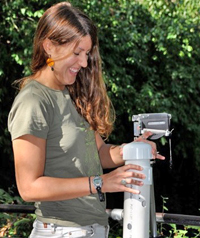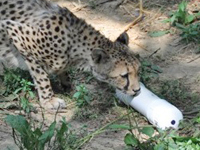

Smith senior Lily Maynard is investigating a new way for zookeepers to keep their animals engaged and behaving more as they would if they were living on a savanna rather than in an enclosed habitat.
/ Published February 11, 2011
Many Smith seniors studying in the sciences are using their final year to dig deep,
ask questions, and conduct original research for honors theses that open new horizons and
make discoveries new to science. Insight has profiled three of those projects.
When zoo patrons visit big cats, they expect to see cheetahs doing things cheetahs do: running, jumping and exploring their surroundings. But zoo animals are often too stressed to act as they would in the wild and instead pick up strange behaviors such as pacing around cages and turning their heads nervously, says Lily Maynard ’11, completing her honors thesis in the biological sciences.

Lily Maynard prepares a tube of scents, which will be introduced into the cheetahs' habitat. “Cheetahs communicate with their smells and inspect their ecosystem through that understanding,” she says.
Maynard is investigating a new way for zookeepers to keep their animals engaged and behaving more as they would if they were living on a savanna rather than in an enclosed habitat. She wants to determine whether the smells that cheetahs would encounter in their natural environment will affect their behavior—with the hope that zoos could then use such smells as environmental enrichment tools.
Keeping animals excited and surprised is valuable in maintaining healthy animals and in creating the best possible experience for zoo patrons, Maynard says. “If you want to show a species, you want to see its natural behaviors.”
The zoo environment, with predictable schedules that don’t capture the excitement of everyday life in the wild, can leave animals just plain bored. So in most zoos, keepers deliberately change what animals encounter every day—whether it’s altering a feeding time, giving animals a new object or toy, or serving different food—to keep them interested.
For cheetahs, the process often involves adding new scents to the cats’ quarters, as all cats communicate through smells. But the scents introduced by the zoo, such as lavender or cologne, are often not those that cheetahs would encounter in the wild. Instead, Maynard introduced what she calls “ecologically relevant smells”—the urine of lions, zebras, caracals (a small African cat) and bongos (a small African antelope)—to 15 cheetahs at the Cincinnati Zoo and Botanical Garden.
It’s thought that new smells will affect cheetah behavior because of the importance of scent in the wild. “Cheetahs communicate with their smells and inspect their ecosystem through that understanding,” Maynard says. When a cheetah encounters a zebra scent, for example, it might decide to follow the trail of potential prey.
In the 20 minutes following the introduction of a tube full of the pungent scents, Maynard
observes every detail of the cheetah behavior, including how many times the cats smell it,
whether they approach it multiple times and whether their attitudes change to be more exploratory,
aggressive or submissive.

Once the scent is introduced to the cheetahs’ habitat, Lily studies the ensuing behavior.
Mayard records the behaviors with a video camera so that she can review it and fill out
what animal behaviorists call an ethogram: an extensive list of possible behaviors, such
as smelling, licking, biting, rolling around or hissing. Maynard hopes that comparing the
behaviors of cheetahs encountering the scented objects with those encountering unscented
ones will reveal whether the cats behave differently when stimulated by those smells.
If those ecologically relevant smells do stimulate the cheetahs, they offer a valuable
new and cost-effective way for zoos to keep their cats engaged, Maynard says. “Zoos
may be able to use their own resources for enrichment.”
Maynard says that similar studies on snow leopards and lions have shown that natural smells
do affect the animals’ behavior, but her study is the first of its kind to investigate
cheetahs. Projects like these are difficult to undertake because few zoos have large enough
populations of big cats to draw clear conclusions.
The Cincinnati Zoo has a uniquely large cheetah population because it houses a breeding center as well as those “display cats” that zoo patrons see. Since her father is the director of the zoo, Maynard has grown up with these big cats. During January and spring break, Maynard hopes to conduct similar experiments with cheetahs at other nearby zoos.




















